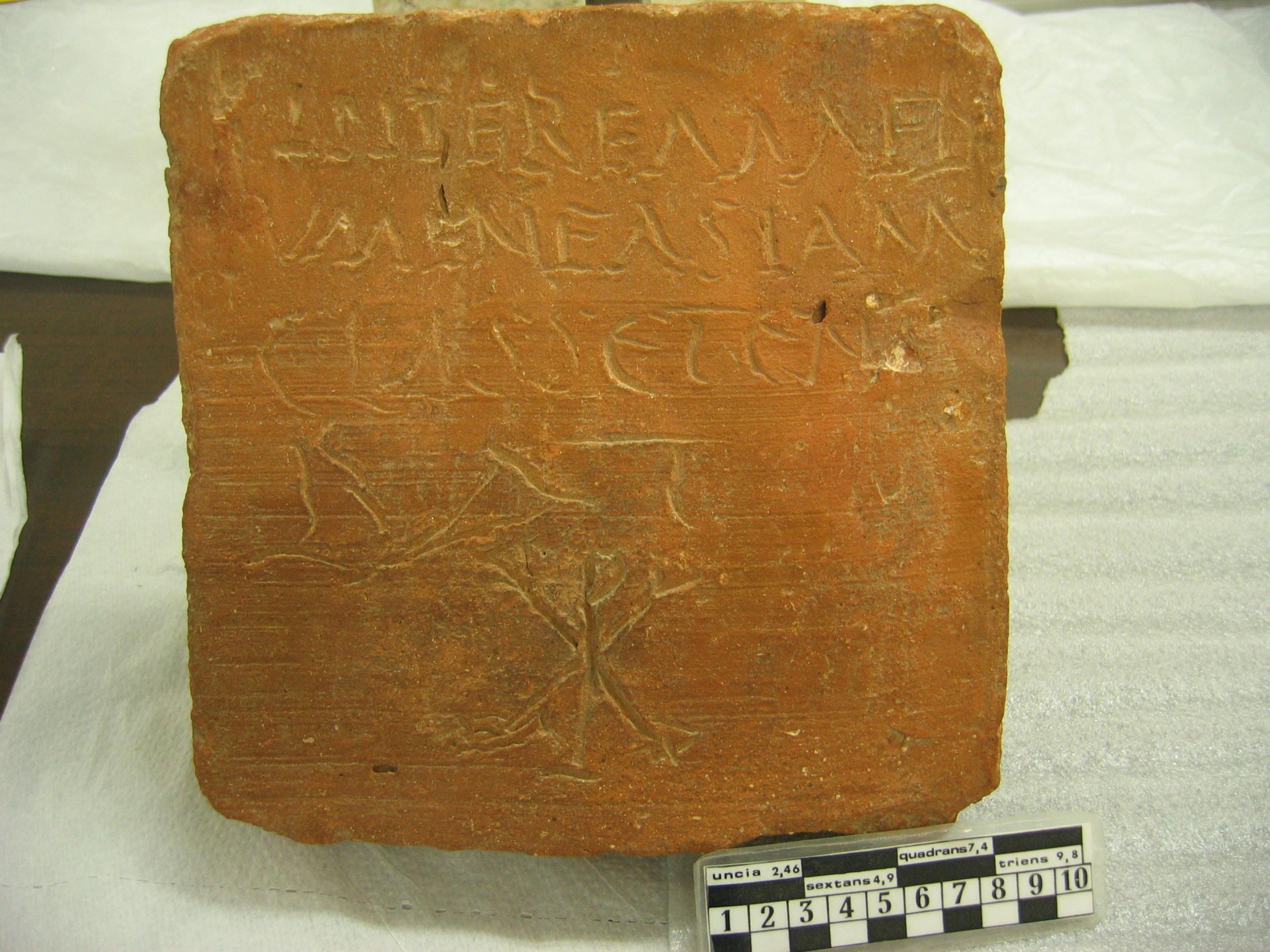BA1
Reference CLE 2293 | Description | Lyrics | Location | Chronology | Epigraphic edition | Translation | Apparatus | Comentary | Type of verse | Text divided into verses and metric signs | Images | Bibliography | Link to DB | Author |
BA1
Description
- Idno filename 22/01/0035
- Type of inscription: Incerti generis
- Support: Brick
- Material: Clay Material Description: Reddish colour.
- Dimensions height/width/depth (cm): 19/19/5
-
Epigraphic field:
- Layout: Inscription engraved before firing.
- Decoration: The lower third has a simple chrismon, the X-shaped strokes ending in triangular finials.
Lyrics
- Font:Book capital
- Letter size:1,5; 1,7; 2,5-1,8; 3,2-2,5 cm
- Description of the letters:E with uncial shape.
Location
- Place of discovery: From Aceuchal (Badajoz), where it was found at the end of the 19th century, it was given to the Archaeological Museum of Mérida before 1906 and transferred to the MAN in Madrid in 1955.
- Geolocation
- Conservation location: It is in the MAN in Madrid, room XXII.
- Inventory number: 1955 / 58 / 1
- Location with Modern Nomenclature España / Badajoz / Aceuchal
- Location with Old Nomenclature Hispania / Baetica / Hispalensis
Chronology
- Inscription's dating: Between year 301 and year 399
- Dating explanation: For palaeographic reasons and the shape of the chrismon.
Type of verse
- Type of verse: Hexameter
- Verse/line correspondence: No
- Prose/verse distinction: No
Epigraphic edition
interea medi-
um Eneas iam
classe tene-
bat
5 ⊂chrismo⊃
Text divided into verses and metric signs
Interea medium (A)eneas iam classe tenebat. lkk|l/kk|ll|l/l|lkk|l~
Translation
Meanwhile Aeneas was already with his fleet, far out at sea.
Bibliography
Monsalud 1900, 477 (inde Diehl, ILCV 2794; Mélida 1925, 41; Vives, ICERV 48; Mallon – Marín 1951, 200, tab. XIX, et 259); Monsalud 1906, 490 (inde Lommatzsch, CLE 2293, cuius exemplum in linguam Hispanicam vertit Fernández Martínez 1998-99; Diehl 1930, n. 1144); Smit 1916, 137; Rodríguez Moñino 1940, 52; Mallon 1948, 110–143, im. 2 (AE 1950, 25); id. 1950, 104–137; id. 1952, 89–92; de Navascués 1956, 536–539; Hoogma 1959, 268; Courcelle 1984, 379; Rodríguez Díaz 1986, 194; Mayer 1993, 861–862, tab. 2; Núñez 1994, 347–350; del Hoyo et alii in Fernández Martínez, CLEB, BA1, cum im. phot, qui in linguam Hispanicam vertit; Cugusi 2012, 181d. – Cf. Marrou 1959, 175–178; Canellas 1966, 27, tab. V; Gil 1976, 547–550; Arce et al. 1997, 420; Abascal – Gimeno 2000, 70; cf. PARDO Y RODRÍGUEZ 2008, 24 cum im. phot. 56.
Apparatus
1 interi(it) fam(ula) Dei F|ilumene Asiana | c(a)l(end)as Se(p)ten(bres) e|ra T. Monsalud 1901; med|[i]um Mallon – Marín.
Comentary
The first editor, the Marqués de Monsalud, informed of its existence in 1901 with an
totally unrecognisable reading which omitted the chrismon. This suggests that he had not seen
the original. This reading gave rise to the false epitaph of a supposed Filumene Asiana (ILCV
2794). The first editor to identify the Virgilian line was Smit (1916). The Marqués de
Monsalud himself (1906, 490) informed of the text appearing on a black slate, supposedly
from Solana de los Barros (Badajoz), with the same first line from book V of the Aeneid,
followed by a chrismon. Rodríguez Moñino (1940) and Vives (1942) discovered that both
texts were identical and that therefore there must be a false one; in 1948 Mallon showed that
the slate was a copy of the brick. This verse is quite frequently quoted (cf. Petron. 68,4;
Macr., Sat., 5,2,12, among others). L. 2 Eneas, with monophthongisation.
Author
- Author:J. Del Hoyo Calleja, J. Gómez Pallarès, J. Martínez Gázquez, J. M. Escolà Tusset
- Last Update2024-07-25 11:01:31
- Autopsy date:2006
You can download this






